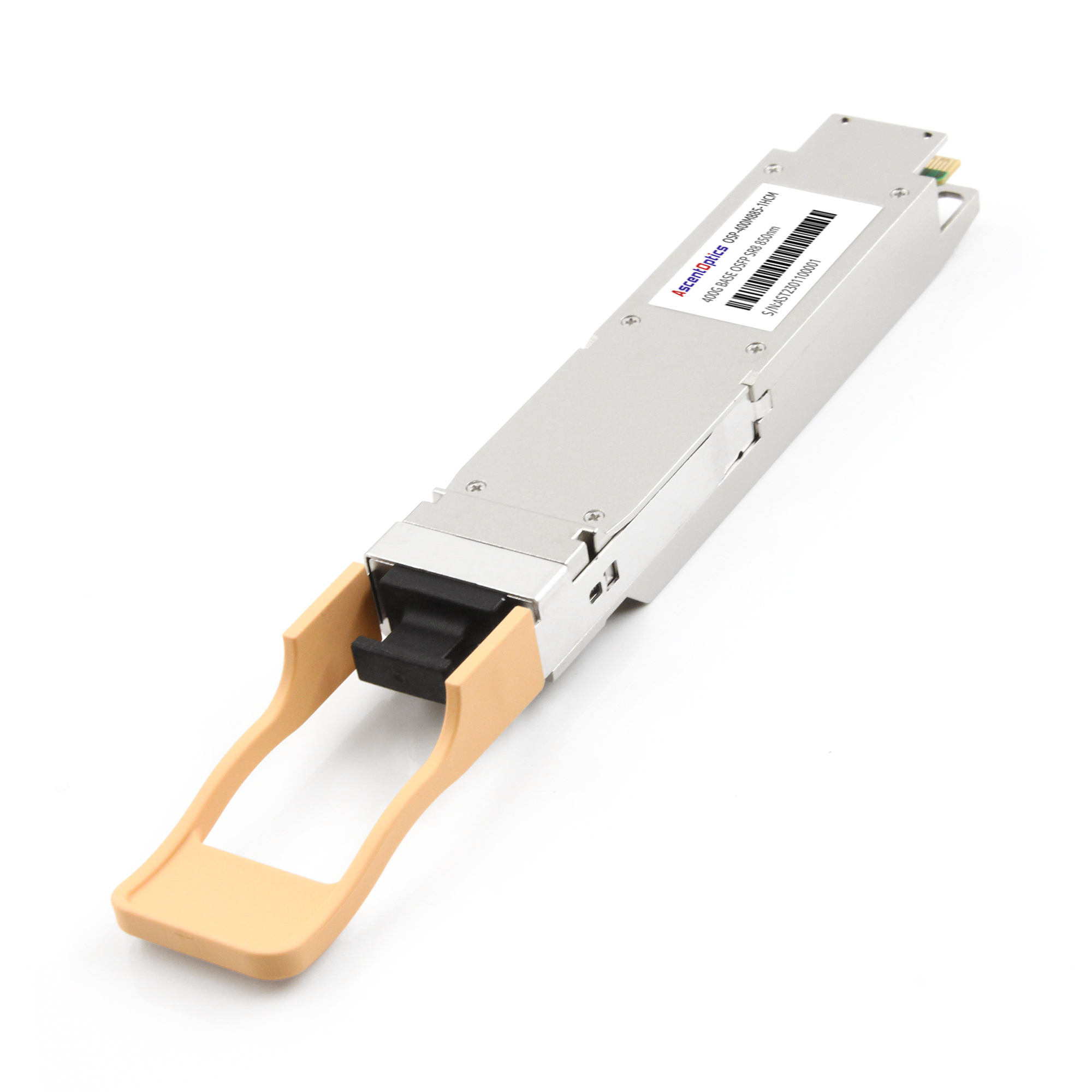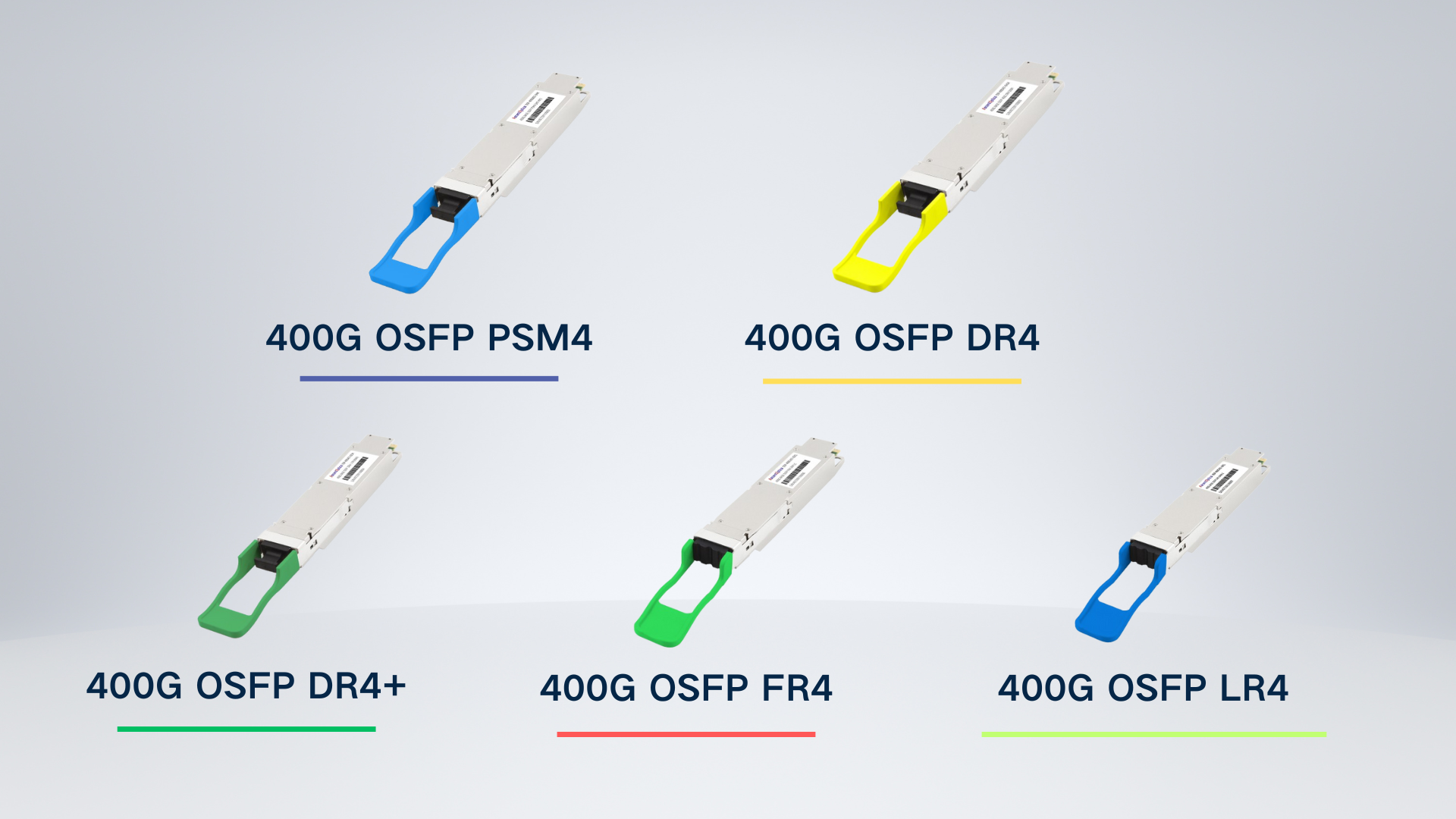The Optical Small Form Factor Pluggable (OSFP) transceiver is a next-generation transceiver module rapidly gaining traction in high-speed networking. It is designed to accommodate future networks’ increasing data rate demands, specifically the 400G Ethernet. The OSFP transceiver is not just about higher data rates; it’s also about improved density, lower power consumption, and better heat dissipation. The unique design and advanced features of the OSFP transceiver make it an ideal choice for large-scale data centers and telecom service providers, where performance, scalability, and efficiency are paramount.
The Optical Small Form Factor Pluggable (OSFP) is an optical transceiver module for high-speed data communication. OSFP modules are created to handle data rates ranging from 8G to 400G, making them versatile for various high-speed networking applications. The OSFP transceiver is more prominent than its predecessors, allowing better heat dissipation and accommodating more complex and sophisticated circuitry needed for higher data rates. Its design also features improved power efficiency and density, proving that OSFP is about speed and overall performance and efficiency.
The OSFP transceiver has many features that make it advantageous for high-speed network environments. One of the most prominent features of the OSFP transceiver is its ability to support the 400G Ethernet, thereby making it suitable for high-speed data communication. The OSFP transceiver is designed with an advanced thermal design, allowing it to dissipate heat more effectively than previous transceiver models. This feature is essential, as higher data rates generate more heat.
Another significant benefit of the OSFP transceiver is its high port density. The design of the OSFP housing enables the efficient use of front panel space, facilitating a higher number of ports than previous transceiver designs. This increased port density is critical for data centers and telecom operations, where maximizing available space is crucial.
Regarding power efficiency, OSFP transceivers are superior to older transceiver models. They’re designed to minimize power usage, which can significantly reduce operational costs and the environmental impact of large-scale networking operations.
One more advantage offered by OSFP transceivers is their versatility. They can support various signal types, including electrical and optical signals, and can accommodate different data rates, making them adaptable to various networking needs.
The OSFP transceiver is an excellent choice for any high-speed networking environment, given its high data rate capability, superior thermal design, high port density, power efficiency, and versatility.

The 400G OSFP (Optical Small Form Factor Pluggable) transceiver is a game-changer in high-speed data communication. With its ability to support 400 Gigabit Ethernet, this transceiver module is designed to accommodate the growing demands of modern networking environments. It stands out for its speed and enhanced heat dissipation capabilities, less power consumption, and superior port density, making it an efficient solution for large-scale networking operations.
The 400G OSFP Transceiver is a pioneering device in the industry, built to manage a whopping data rate of 400 Gbps. This transceiver module is an advanced model that offers a seamless bridge between higher data transmission rates and operational efficiency. With its larger size compared to previous models, it manages heat dissipation quite well, which is essential for maintaining optimal performance. The 400G OSFP Transceiver signifies a giant leap forward in high-speed optical networking.
The 400G OSFP Transceiver offers various benefits, making it a preferred choice in high-speed data communication. Its ability to support 400G Ethernet provides a significant speed advantage over older models. The advanced thermal design of the 400G OSFP Transceiver ensures effective heat management, which is crucial when handling higher data rates. Furthermore, the high port density design of the OSFP housing ensures efficient utilization of front panel space, which is essential in data centers and telecom operations. The 400G OSFP Transceiver also excels in power efficiency, reducing operational costs and environmental impact. Lastly, its versatility in supporting various signal types and data rates makes it adaptable to diverse networking needs.

400G OSFP optical modules can be categorized into various types based on transmission distance, fiber type, and modulation format. Below are the mainstream models and their key characteristics:
Ideal for intra-rack connections and short-distance interconnects in data centers and AI/GPU clusters.
| Model |
OSFP-400G-SR4 |
OSFP-400G-SR8 | |
| Transmission Distance |
100m |
100m |
100m |
| Fiber Type |
MMF (OM3/OM4) |
MMF (OM4) |
MMF (OM4) |
| Interface |
MPO-12 |
MPO-16 APC |
MPO-12 |
| Modulation Format |
4×100G PAM4 |
8×50G PAM4 |
4×100G PAM4 |
| Power Consumption |
≤8W |
≤10W |
≤12W |
| Application |
Intra-rack interconnects in data centers |
high-density short-reach connections |
400G Ethernet/ Infiniband interconnects |

Features:
Cost-effective: Utilizes VCSEL lasers, offering lower cost compared to single-mode modules.
High density: MPO-12/16 interface supports multi-channel parallel transmission.
Ideal for data center interconnect (DCI), metro networks, and inter-building connections.
| Model |
OSFP-400G-PSM8 |
OSFP-400G-DR4 | OSFP-400G-DR4+ | OSFP-400G-FR4 |
OSFP-400G-LR4 |
| Transmission Distance |
300m |
500m | 2km | 2km |
10km |
| Wavelength |
1550nm |
1310nm | 1310nm | CWDM4 |
CWDM4 |
| Fiber Type |
SMF |
SMF | SMF | SMF |
SMF |
| Interface |
MPO-16 |
MPO-12 | MPO-12 | Duplex LC |
Duplex LC |
| Modulation Format |
PAM4 |
PAM4 | PAM4 | PAM4 |
PAM4 |
| Power Consumption |
≤9W |
<10W | <10W | <10W |
<12W |
| Application |
Data Center Interconnect |
Data center networks/
4 x 100G-DR4 applications |
Data center networks
4 x 100G-DR4+ applications |
4x100G FR applications
/Data Center |
4 x 100G-LR4 applications /Data center |

Features:
DR4: MPO-12 interface, suitable for high-density cabling (e.g., InfiniBand NDR networks).
FR4/LR4: Uses CWDM4 wavelengths (1271/1291/1311/1331nm), compatible with DWDM systems.
Low-Power DSP: Some models support Gearbox chips (8×50G electrical to 4×100G optical conversion).
(1) Liquid-Cooled Data Centers
OSFP-400G-FinnedTop: Designed with heat-dissipating fins, compatible with liquid-cooled switches (e.g., NVIDIA Quantum-2).
OSFP-400G-LiquidCooled: Fully liquid-cooled packaging with power consumption ≤12W, ideal for supercomputing centers.
(2)Breakout Interconnection
OSFP-400G-2x200G: Supports splitting one 400G port into two 200G links (e.g., for connecting 200G NICs).
OSFP-400G-4x100G: Splits into four 100G links, used in HPC clusters.
OSFP-400G-DAC (Direct Attach Copper): ≤3m (passive), ≤7m (active), for short-reach in-rack connections.
OSFP-400G-AOC (Active Optical Cable): ≤100m, a substitute for multimode fiber.
The selection of 400G OSFP optical modules should take into account transmission distance, fiber type, power consumption, cost, and future scalability. With the growing adoption of 800G technology, 400G OSFP remains one of the mainstream choices for data centers and AI networks, especially playing a vital role in InfiniBand NDR and RoCEv2 networks.
Transitioning from QSFP-DD (Quad Small Form Factor Pluggable Double-Density) to 400G OSFP transceivers requires thoughtful planning. DUE TO DIFFERENT SIZES AND PIN CONFIGURATIONS, the QSFP-DD and OSFP form factors are not directly interchangeable. However, conversion modules or adapter cables are available to facilitate this transition, allowing QSFP-DD transceivers to function within an OSFP-designed infrastructure.
Direct Attach Cables (DAC) are integral to 400G OSFP transceiver connections. These robust, high-speed cables provide a cost-effective solution for short-distance data transmission. They come with transceivers directly attached at each end, offering a seamless plug-and-play solution for data centers and high-speed networking environments. Like their transceiver counterparts, the 400G OSFP DACs are designed with superior thermal and power efficiency in mind.
Optical connections for the 400G OSFP transceiver offer a high-performance, reliable medium for long-distance data transmission. They utilize fiber optic cables, capable of transmitting light signals over vast distances with minimal loss. This makes optical connections ideal for applications that require high-speed transmission over long distances, such as telecom networks and inter-data center connections. The 400G OSFP transceiver supports a variety of optical links, including single-mode and multimode fibers, to meet diverse networking requirements.
Data centers stand at the forefront of the digital revolution, handling massive amounts of data daily. The 400G OSFP transceivers play a critical role in the seamless operation of these data centers, providing high-speed, efficient, and reliable data transmission. Whether short-range connections within the data center or long-haul data center interconnect, 400G OSFP transceivers offer a comprehensive solution catering to diverse data communication needs.
400G Ethernet, a significant evolution in Ethernet technology, offers unmatched speed and efficiency. When paired with 400G OSFP transceivers, it enables data centers and telecom networks to handle higher data traffic volumes, thereby boosting their overall performance. The compatibility of 400G Ethernet with various types of 400G OSFP transceivers adds to their flexibility and adaptability, supporting multiple applications from intra-data center connectivity to long-haul telecom networks.
The 400G OSFP transceivers are designed to cater to different distance requirements. The SR8 and the DR4 variants are designed for shorter distances (up to 2km), making them suitable for applications within data centers. On the other hand, the LR4 transceiver allows for data transmission over longer distances (up to 10km), making it ideal for applications involving data center interconnects and telecom networks.
As the demand for high-speed data communication continues to rise, the adoption of 400G OSFP transceivers is set to grow exponentially. Their versatility, efficiency, and high-speed capabilities are future-proof solutions for next-generation digital infrastructures. As technologies continue to evolve, we can expect further enhancements to these transceivers, strengthening their role in the ever-changing landscape of data communication.
A: An OSFP (Octal Small Form-factor Pluggable) transceiver is a high-speed optical transceiver module used in networking equipment to transmit and receive data over optical fibers.
A: There are several types of OSFP transceivers available, including OSFP FR4, OSFP DR4, and OSFP SR8. Each class has different specifications and is designed for specific network requirements.
A: OSFP FR4, OSFP DR4, and OSFP SR8 are different types of OSFP transceivers that support different transmission distances and optical specifications. FR4 is designed for distances up to 2km, DR4 for distances up to 10km, and SR8 for short-range connections.
A: PAM4 (Pulse Amplitude Modulation 4) is a modulation technique used in high-speed optical transceivers like OSFP. It allows for higher data rates by encoding four different signal levels, enabling faster transmission speeds.
A: An AOC is an active optical cable used to connect OSFP transceivers over short distances. It combines the functionality of a transceiver and fiber optic cable into a single, ready-to-use solution.
A: No, OSFP transceivers are designed to work with single-mode fibers and are incompatible with multimode fibers.
A: An OSFP transceiver supports up to 8 electrical lanes, allowing for high-speed data transmission.
A: The OSFP MSA (Multi-Source Agreement) group is an industry consortium that defines the standards for OSFP transceiver modules. It ensures compatibility and interoperability between different manufacturers’ products.
A: A 400G OSFP transceiver can support a maximum data rate of 400Gbps.
A: Depending on the specific OSFP switch or system, it can support up to 32 OSFP ports per 1U front panel.
Recommend Reading: 400G OSFP For Sale
800G OSFP Optical Transceiver Module – Lighting Your Network with High-Speed Connectivity